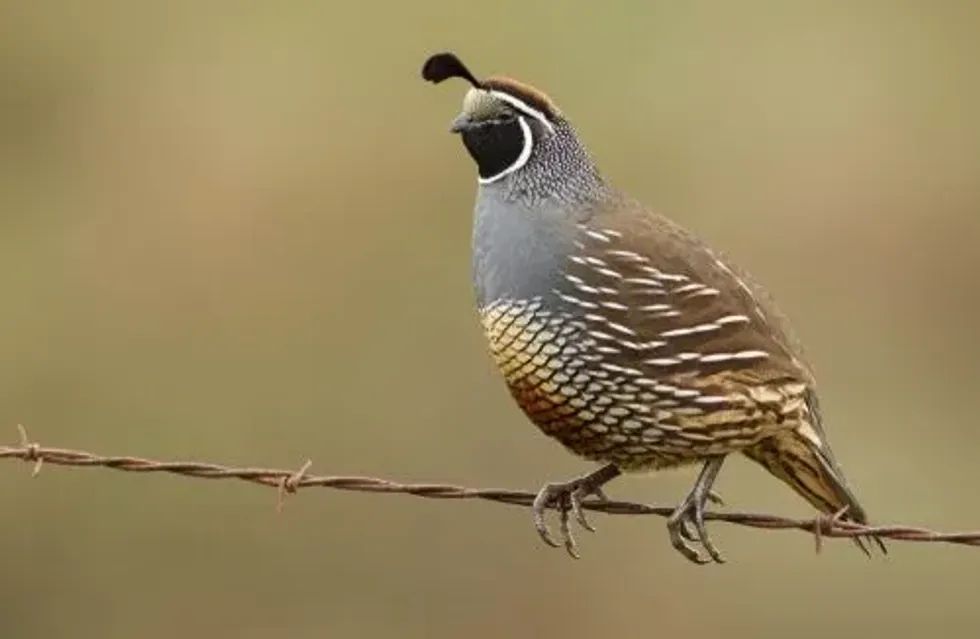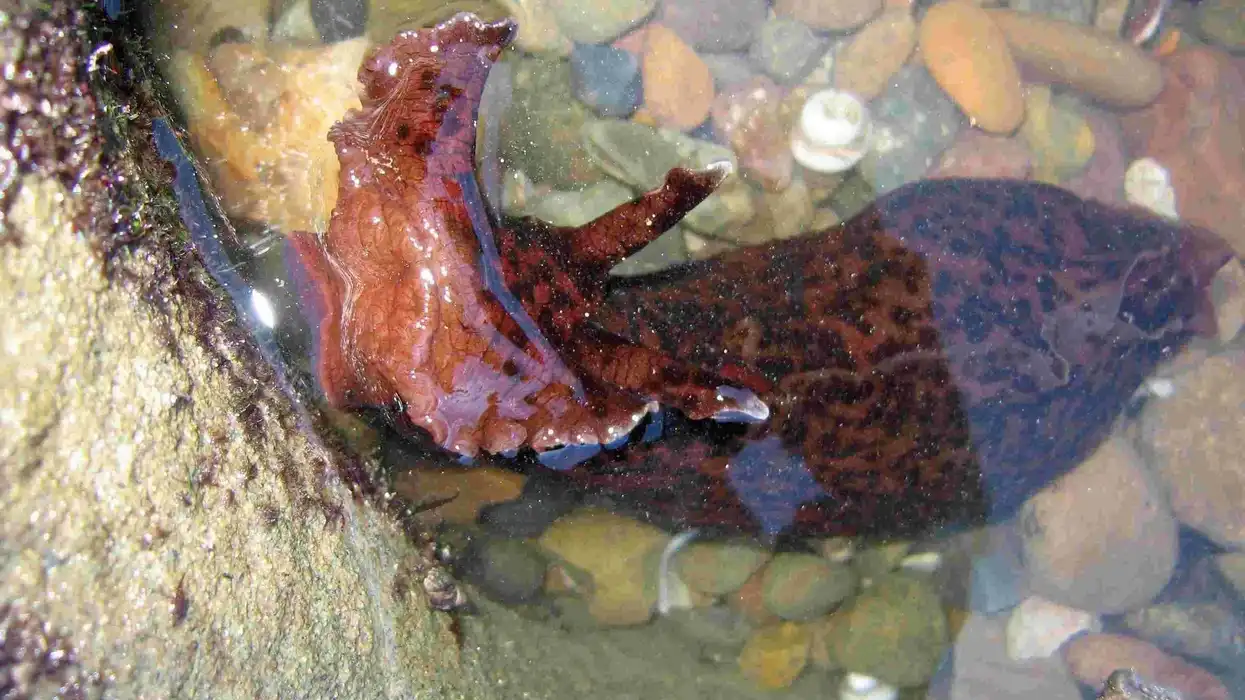With an inverted forward drooping tear-drop-shaped topknot, the California Quail (Callipepla californica) is a beautiful looking, medium-sized, ground-dwelling bird. It belongs to the New World quail family and is also popularly known as the Valley Quail and the California Valley Quail.
It is commonly sighted on the Californian coast and is also the state bird of California. It features a round belly, wide wings, a squarish tail, a short neck, and scaled markings on its body that make it looks pretty attractive.
It moves around in large groups called coveys and forages the ground for food.
This species of birds largely stay on the ground, but they run for cover or fly away swiftly with whirring wings when sensing danger. California Quail calls 'chi-ca-go' and can be easily heard in the areas they frequent.
Read on to uncover some fascinating California Quail facts for kids. We have a lot of exciting and informative content on birds posted here like hermit thrush and evening grosbeak facts.
California Quail Interesting Facts
What type of animal is a California Quail?
The California Quail (Callipepla californica) is a medium-sized, attractive, ground-dwelling North American bird. It is a social bird and lives in groups. Since it spends most of its time on the ground, it has short but strong legs, which it uses for running for cover in case of danger.
What class of animal does a California Quail belong to?
The California Quail belong to the Aves class, order Galliformes, and family Odontophoridae.
How many California Quails are there in the world?
It is one of the most common North American birds. As per the Partners in Flight organization, the California Quail has an estimated global breeding population of 3.8 million.
It is worth mentioning here that it is a popular game bird, and as many as 800,000-1.2 million are hunted in California alone. Despite this level of hunting, their population is quite stable.
Where does a California Quail live?
The California Quail is most common on the West Coast of the United States. Typically from Southern Oregon to Baja California, it eventually spread to Arizona, Utah, Idaho, and Nevada. Since the bird can adapt to various habitats, it is also introduced to countries like Australia, New Zealand, Chile, South Africa, Brazil, Peru, and Argentina.
What is a California Quail's habitat?
The California Quails' most preferred habitat is an open area with small shrubs around, perfect for hiding. Typically, it lives in the open woodlands, coastal sagebrush, near chaparral, foothills, parks, forest edges, steppe zones, and traditional agricultural fields. They also visit backyards where bird seeds are placed on or near the ground.
Who do California Quails live with?
Calfornia Quail live in groups called coveys which consist of 10-100 or more birds during the winter season. When the breeding season starts, they form pairs.
How long does a California Quail live?
The average age of California Quail is two to three years. However, there are some exceptions. The oldest known California Quail lived till the age of 6 years 11 months.
How do they reproduce?
The male California Quail competes for a mate. They spread their tail, bob their head, and droop the wings to entice the female.
They mate with only one female. The male perch on the tree and call out to mark the territory. They usually roost on the tree to avoid the sun and predators and forage for food in the morning and night.
These birds typically have their nests in the ground; they choose well-concealed spots by vegetation. The nest is usually a shallow depression in the ground about 5-7 in across and 2 ins deep and is lined with grass and twigs.
The female lay around 12- 16 eggs; they are cream in color with brown markings. The incubation of the eggs is taken care of by the female.
The male protects the nest and takes care of the food. The incubation period lasts three weeks.
The birds avoid confrontation of any kind till the eggs hatch and the young chicks are mature. Soon after birth, the young chicks leave the nest, and at about ten days of age, they try to fly. Till about a month, they stay on the ground, after which they roost on trees with their coveys.
Both parents take care of the young birds. At about ten months of age, the Californa Quails are mature for breeding.
What is their conservation status?
As per the IUCN list, this species of birds are listed in the Least Concern category.
California Quail Fun Facts
What do California Quails look like?
The California Quail is an attractive bird. Like many other bird species, the males feature bright and vibrant colors compared to the females.
The males of this species have a prominent plume, black face with white outline, dark brown cap, and their body is covered with gray, white, and bluish-colored feathers. The females have a less prominent plume and are gray-brown in color. The plume appears like a single large feather, but it is a cluster of six overlapping feathers.
How cute are they?
With their short beak, plump body, and distinctly scaled plumage, the California Quails look pretty cute. That's one reason why they are a very popular game bird.
How do they communicate?
These North American birds communicate through shrill calls and cackles; their main call comprises three syllables and sounds like 'chi-ca-go'. The bird gives out this call to alert others in the event of separation from its covey or if the group is preparing to move.
The call can be repeated multiple times in succession. It also uses a 'pit-pit' call when they sense danger and want to alert their covey about it.
The mated pair exhibit antiphonal calling, where the female's 'chi-ca-go' call is interrupted by shrill squills by the male. It is quite an experience to hear California Quail calling.
How big is a California Quail?
California Quail is a medium-sized bird. Their length is in the range of 9.4-10.6 in (24-27cm). The males are slightly plumper than the females. Its relative size is about half the size of a Ring-necked Pheasant.
How fast can a California Quail fly?
California Quails are sedentary birds, and their maximum movement is recorded up to 16.8 miles. They can fly away fast when threatened but only for short distances. Their in-flight speed is about 38-58 mph.
How much does a California Quail weigh?
The bird's average weight is in the range of 0.3-0.5 lb (140-230 g).
What are their male and female names of the species?
There are no specific names for males and females of this species. They are referred to as male and female California Quail, respectively.
What would you call a baby California Quail?
Baby California Quails are called chicks.
What do they eat?
They are primarily granivores, as their diet consists of seeds like clover, pea, and lupine. They also eat berries, acorns, grains, and fruits. When the breeding season starts, they prey on invertebrates like snails and feed on insects like beetles, crickets, and caterpillars. So they can be called omnivores.
Are they dangerous?
No, they are not dangerous to humans.
Would they make a good pet?
Yes, California Quails make good pets. You can attract them into your backyards by leaving bird seeds on the ground. To keep them as pets in enclosures, get some healthy birds from a reputable breeder, as the ones from the wild can be a carrier of diseases.
Did you know...
Here is one of the fascinating California Quail facts - the baby California Quails feast on the poop of adult quails. Adult birds have a particular organism in their digestive tract that is crucial for digesting vegetation. Since the young birds do not have them, they feed on the feces to get them.
California Quail's mating and breeding
California Quails are not monogamous birds; they are often seen to have communal broods that include multiple members of each sex. Once the eggs are hatched, the brood mix and all the family take care of the young birds.
The bird has one brood a year. Some of their nest are seen to have as many as 28 eggs; this is because of behavior called egg-dumping, where two to three females lay their eggs in the same nest.
Quails in California
The Quail season in California for Mountain Quails is around mid-September to mid-October. The state's wildlife department releases the dates, and people with a hunting license can hunt for these birds under specific terms.
The California Quail was chosen as the state bird of California on 14 August 1931, by the legislature. The Audubon Society recommended it as an apt insignia for the state as California Quails were common throughout California.
Here at Kidadl, we have carefully created lots of interesting family-friendly animal facts for everyone to discover! Learn more about some other birds, including secretary bird, or common kingfisher.
You can even occupy yourself at home by drawing one on our California quail coloring pages.










